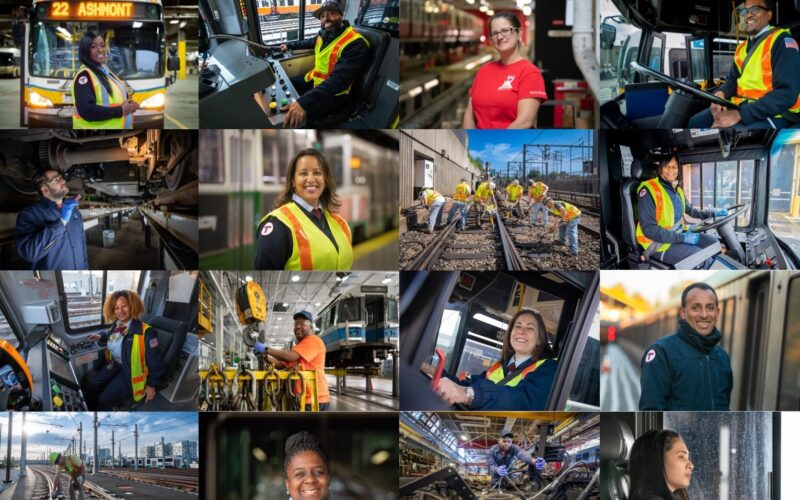
The national transit operator and maintenance worker shortage is nothing less than an emergency, resulting in cuts to transit service affecting millions of riders and impeding a robust COVID recovery. This Transit Equity Day, we’ve partnered with the Alliance for a Just Society and the Labor Network for Sustainability on a new report that calls on transit agencies to prioritize workforce investments.
The report, “Invest in Transit Equity, Invest in Transit Workers,” chronicles how the pandemic has compounded other factors that were destabilizing the transit workforce long before COVID arrived, leaving public transit systems unable to meet the needs of the people who rely on their service every day.
Transit Equity Day, February 4, commemorates the birthday of Rosa Parks and draws attention to the connections between racial justice and an equitable transportation system. The emergency facing American transit today reminds us that achieving transportation equity is simply not possible without a stable and healthy transit workforce.
As of October 2021, employment in public transit and ground transportation was at 84 percent of pre-pandemic levels. This understaffing has led to reduced or hampered transit service in cities from Charlotte to Ann Arbor to Pittsburgh to Columbus. And it’s not just a big city problem. Rural transit systems in places like Northeast Missouri, Greater Peoria, Illinois, and Steamboat Springs, Colorado, are also being affected.
This has enormous implications for racial equity. Nationally, 60 percent of all public transit riders are people of color; one quarter are Black, and almost 20 percent are Latinx/Hispanic. Black people across the country are more likely than white people to count on buses, trains, and other forms of public transit as their primary transportation option, and are more likely to use public transportation to get to work. Essential workers, such as health aides, hospital workers, and grocery workers, are more likely to use public transit and to be people of color
Public transit is also an important source of employment for workers of color overall, who account for half of vehicle operators and form a large share of frontline transit workers. Investing in transit jobs means investing in workers of color.
There is no single answer to transit agency staffing issues, and the needs across agencies can vary dramatically. The first step is engaging workers directly in the process through their union representatives – transit workers know better than anyone how best to improve the quality of their jobs.
It’s also essential to note that agencies need more funding overall to retain and attract drivers. The recently enacted Infrastructure Investment and Jobs Act (IIJA) does provide a significant increase in capital funding for state departments of transportation and transit agencies, which can help fund needed improvements in bus garages and facilities and on buses themselves to create a safer, healthier working environment. Additionally, agencies are encouraged to use IIJA funds for workforce development, training, and education activities. But although this funding provides an opportunity to address some workforce needs, much greater ongoing investment is necessary.
Here are a few of the report’s topline recommendations – read the full report to learn more.
Ensure family-sustaining wages and good working conditions for all transit workers
- Wages and benefits, including signing and retention bonuses, should ensure transit workers can live and retire in the communities they serve. Agencies should also provide ample sick time, hazard pay, and shifts that allow for reasonable schedules and time off.
Protect the health and safety of transit workers
- Agencies should provide plexiglass, driver-side exits, and other operator protections and ensure proper fresh air ventilation and PPE as needed. Agencies should also take steps to ensure adequate restroom breaks, provide opportunities for physical activity, and invest in employee mental health.
Expand access to transit jobs and invest in workforce development
- Agencies should remove barriers to transit jobs that exclude people with minor past offenses. They should also invest in apprenticeship, pre-apprenticeship, and mentorship programs, and employment pipelines developed through labor-management cooperation, and provide current transit employees with opportunities for promotions.
Provide training and workforce development to help protect workers who could be displaced by electrification and other modernization efforts
- Agencies should provide training and retraining of operators and maintenance employees on zero-emissions vehicles, and ensure that maintenance of vehicles is performed by agency employees and not outsourced.
TransitCenter will be exploring the operator shortage in greater depth in a forthcoming report and event series that looks at steps some agencies have taken to hire and retain more workers – please stay tuned!
 New Drug Testing Rule from USDOT Could Help Alleviate the Bus Operator Crisis
New Drug Testing Rule from USDOT Could Help Alleviate the Bus Operator Crisis
New drug testing rules from the USDOT could make it easier for transit agencies to recruit more operators - but only if they implement the rule.
Read More MBTA Partners with Union to Reach Historic Wage Agreement
MBTA Partners with Union to Reach Historic Wage Agreement
The Massachusetts Bay Transportation Authority and its union, Carmen’s Local 589, reached a historic agreement to increase bus operators' starting wages from $22.21 to $30 an hour, shifting MBTA operators from the lowest paid to the highest paid in the transportation industry.
Read More